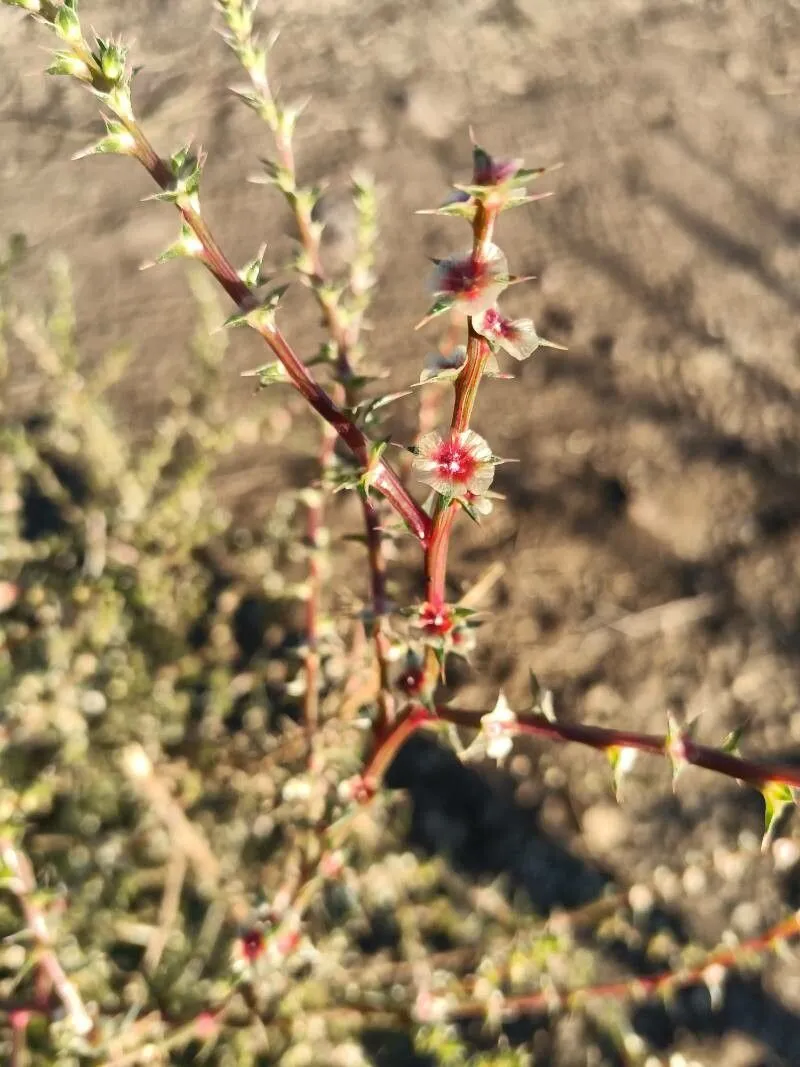
Author: L.
Bibliography: Sp. Pl.: 222 (1753)
Year: 1753
Status: accepted
Rank: species
Genus: Salsola
Vegetable: Unknown
Observations: Macaronesia, Atlantic coasts to Medit.
Roly-poly, scientifically termed Salsola kali, is a fascinating and rugged member of the Amaranthaceae family. First chronicled by the renowned botanist Carl Linnaeus in 1753 in his seminal work “Species Plantarum,” Salsola kali has a storied history in botanical literature.
This hardy plant primarily thrives in the harsh coastal environments of Macaronesia and the expansive Atlantic coasts stretching to the Mediterranean. Its ability to endure in such varied and often challenging habitats speaks to its tenacity and adaptability. The common name “Roly-poly” aptly describes its unique behavior: as it matures and dries out, the plant detaches itself from its roots and tumbles across open spaces, thus facilitating the widespread dispersal of its seeds.
Physiologically, Salsola kali is well adapted to saline and arid conditions, a characteristic trait among species found in coastal and desert regions. This trait allows it to survive in environments where many other plant species would find it challenging to thrive. The plant has a bushy, sprawling growth habit with small, narrow leaves that help minimize water loss, and it often adopts a spherical shape, contributing to its tumbleweed lifestyle.
In addition to its ecological adaptability, the roly-poly plant holds significant importance in various ecosystems. It can serve as a pioneer species, stabilizing soils and reducing erosion in vulnerable areas. Its presence in coastal regions also provides important habitat and food sources for local wildlife.
Despite its useful ecological roles, in some contexts, Salsola kali can become invasive, outcompeting native flora and altering local ecosystems. As such, its spread is carefully monitored and managed in various regions to balance its benefits against potential ecological disruptions.
In summary, the roly-poly plant, Salsola kali, exemplifies nature’s ingenuity in adaptation and survival. Its distinctive life cycle, ecological value, and resilience make it a noteworthy subject of study in the plant kingdom.
En: Roly-poly, Common saltwort, Soft roly-poly, Prickly saltwort, Russian thistle, Saltwort, Prickly Glasswort
Ca: Barrella punxosa
Nl: Stekend loogkruid en zacht loogkruid, Stekend loogkruid, Loogkruid
Fr: Soude, Soude brûlée, Soude kali, Salsovie, Soude épineuse
De: Kali-Salzkraut, Kalikraut, Kalisalzkraut, Küsten-Salzkraut, Salzkraut
It: Salsola erba-cali, Salsola erba-kali
Nb: Sodaurt
Nn: Sodaurt
Pt: Barrilha-espinhosa, Barrilheira
Pt-br: Corredor-de-estepe, Cardo-da-Rússia
Gd: Lus an tsalainn
Es: Barrila borde, Barrila pinchosa, Barilla pinchosa
Sv: Sodaört
Cy: Helys Pigog, Helys Ysbigog
Taken Jan 1, 1970 by Endemia – Julien Barrault (cc-by-nc)
Taken Nov 3, 2015 by EOL − Keir Morse (cc-by-nc-sa)
Taken Apr 21, 2022 by Sánchez Ángel (cc-by-sa)
Taken Sep 25, 2022 by Natalie Clement (cc-by-sa)
Taken Oct 30, 2022 by VitinPregunta #Challenge (cc-by-sa)
© copyright of the Board of Trustees of the Royal Botanic Gardens, Kew.
© copyright of the Board of Trustees of the Royal Botanic Gardens, Kew.
© copyright of the Board of Trustees of the Royal Botanic Gardens, Kew.
Taken Aug 27, 2022 by Manu 🍃 (cc-by-sa)
Taken Aug 10, 2020 by Sylvain Piry (cc-by-sa)
Taken Aug 10, 2020 by Sylvain Piry (cc-by-sa)
Taken Aug 22, 2022 by Manu 🍃 (cc-by-sa)
Taken Sep 12, 2019 by Lynne Robinson (cc-by-sa)
Taken Mar 22, 2016 by EOL − Mark Rosenstein (cc-by-nc-sa)
Taken Nov 30, 2014 by EOL − Sam Kieschnick (cc-by-nc)
Taken Jul 6, 2019 by cianflone jaq (cc-by-sa)
Taken Aug 22, 2022 by Manu 🍃 (cc-by-sa)
Taken Aug 10, 2020 by Sylvain Piry (cc-by-sa)
Taken Sep 4, 2020 by Marsen Matressa (cc-by-sa)
Taken Apr 3, 2021 by Trap Hers (cc-by-sa)
Taken Jun 3, 2022 by mer jury massei (cc-by-sa)
Taken Jul 24, 2020 by G B (cc-by-sa)
Taken Aug 10, 2020 by Sylvain Piry (cc-by-sa)
Taken Jan 1, 1970 by Endemia – Julien Barrault (cc-by-nc)
Taken Jul 4, 2010 by EOL − Zoya Akulova (cc-by-nc)
Taken Nov 15, 2008 by EOL − Steve Matson (cc-by-nc)
Taken Oct 22, 2015 by EOL − Laura (cc-by-nc)
Taken Jul 7, 2015 by EOL − Moorpark College Biology Club (cc-by-nc)
Taken Jun 23, 2022 by Anatas (cc-by-sa)
Taken Sep 29, 2020 by Encinas Juan (cc-by-sa)
Family: Myrtaceae Author: (F.Muell.) K.D.Hill & L.A.S.Johnson Bibliography: Telopea 6: 402 (1995) Year: 1995 Status:…
Family: Rubiaceae Author: Pierre ex A.Froehner Bibliography: Notizbl. Bot. Gart. Berlin-Dahlem 1: 237 (1897) Year:…
Family: Sapindaceae Author: Koidz. Bibliography: J. Coll. Sci. Imp. Univ. Tokyo 32(1): 38 (1911) Year:…
Family: Asteraceae Author: A.Gray Bibliography: Pacif. Railr. Rep.: 107 (1857) Year: 1857 Status: accepted Rank:…
Family: Fabaceae Author: Medik. Bibliography: Vorles. Churpfälz. Phys.-Ökon. Ges. 2: 398 (1787) Year: 1787 Status:…
Family: Aspleniaceae Author: (Cav.) Alston Bibliography: Bull. Misc. Inform. Kew 1932: 309 (1932) Year: 1932…